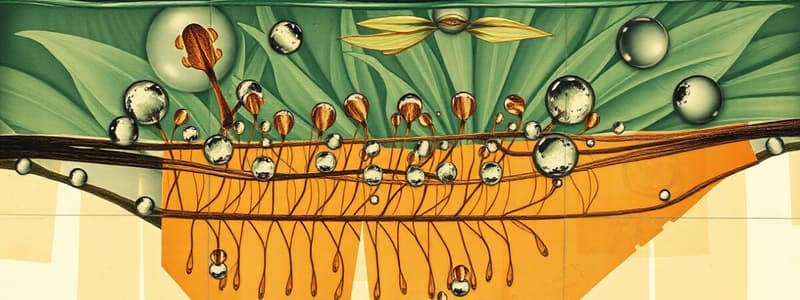Podcast
Questions and Answers
Which component of phloem is responsible for transporting sugars?
Which component of phloem is responsible for transporting sugars?
- Sieve tubes (correct)
- Companion cells
- Root hairs
- Xylem vessels
What is the primary function of sieve tubes in plants?
What is the primary function of sieve tubes in plants?
- Transporting water from roots to leaves
- Storing chlorophyll for photosynthesis
- Facilitating gas exchange in leaves
- Transporting food produced by photosynthesis (correct)
Which process occurs in the cytosol and does not require oxygen?
Which process occurs in the cytosol and does not require oxygen?
- Photosynthesis
- Electron transport chain
- Krebs cycle
- Glycolysis (correct)
Which component of chloroplasts is responsible for absorbing light energy?
Which component of chloroplasts is responsible for absorbing light energy?
What is produced during the Krebs cycle that is essential for the electron transport chain?
What is produced during the Krebs cycle that is essential for the electron transport chain?
Which part of the leaf structure plays the main role in photosynthesis?
Which part of the leaf structure plays the main role in photosynthesis?
What is the ultimate source of energy for photosynthesis?
What is the ultimate source of energy for photosynthesis?
During aerobic respiration, which intermediate product is formed from the breakdown of glucose?
During aerobic respiration, which intermediate product is formed from the breakdown of glucose?
What is primarily responsible for the transport of water and minerals from the roots to the leaves of a plant?
What is primarily responsible for the transport of water and minerals from the roots to the leaves of a plant?
Which component of the leaf structure is responsible for regulating the opening and closing of stomata?
Which component of the leaf structure is responsible for regulating the opening and closing of stomata?
What process is primarily responsible for pulling water through the plant?
What process is primarily responsible for pulling water through the plant?
Which factor does not play a direct role in the movement of water through xylem cells?
Which factor does not play a direct role in the movement of water through xylem cells?
How does a water molecule's movement through the xylem begin?
How does a water molecule's movement through the xylem begin?
What ensures that the next water molecule is pulled through the xylem after one is moved?
What ensures that the next water molecule is pulled through the xylem after one is moved?
What is the main effect of transpiration on water movement?
What is the main effect of transpiration on water movement?
What is the primary function of root hairs in plants?
What is the primary function of root hairs in plants?
Which of the following correctly describes active transport in plant roots?
Which of the following correctly describes active transport in plant roots?
What role do mycorrhizae play in plant nutrition?
What role do mycorrhizae play in plant nutrition?
Which statement correctly differentiates xylem from phloem?
Which statement correctly differentiates xylem from phloem?
What is a significant structural characteristic of xylem tissue?
What is a significant structural characteristic of xylem tissue?
Study Notes
Water Movement in Plants
- Transpiration is the key process that pulls water through plants.
- Osmotic pressure initiates the movement of water molecules through xylem cells.
- Cohesion of water molecules ensures continuity in the transport of water in the xylem.
- A negative pressure created by transpiration enhances water movement upward.
Root Functionality
- Root hairs are primarily responsible for nutrient absorption from the soil.
- Active transport in plant roots involves moving nutrients from low to high concentration using energy.
- Mycorrhizae symbiosis increases root surface area for enhanced nutrient uptake.
Xylem vs. Phloem
- Xylem conducts water and minerals, while phloem is responsible for transporting sugars.
- Xylem tissue is non-living at maturity and reinforced by lignin for structural strength.
- Sieve tubes, part of phloem, are crucial for transporting photosynthesis products like sugars.
Photosynthesis and Respiration
- Chlorophyll, found in chloroplasts, absorbs light energy essential for photosynthesis.
- The Krebs cycle produces NADH, a vital molecule for the electron transport chain.
- The palisade mesophyll predominantly carries out photosynthesis in leaves.
- Solar energy is the ultimate energy source driving the photosynthesis process.
Plant Structure and Function
- Stomata facilitate gas exchange in leaves, regulating oxygen and carbon dioxide levels.
- Guard cells control the opening and closing of stomata to manage gas exchange efficiently.
- Root pressure, generated by osmosis, helps in driving water movement upwards in plants.
Cohesion-Tension Model
- The cohesion-tension model describes how water movement relies on both cohesion between water molecules and their adhesion to plant surfaces.
- Transpiration primarily drives water movement through the evaporation of water from leaf surfaces.
Studying That Suits You
Use AI to generate personalized quizzes and flashcards to suit your learning preferences.
Related Documents
Description
Test your understanding of the processes that facilitate water movement through xylem in plants. This quiz covers key concepts such as transpiration, capillary action, and the factors affecting water transport. Perfect for biology students looking to strengthen their knowledge!




